Video calling on Zoom or Google Meet feels as normal today as a letter by pigeon did in the early 20th century. But there was a time, not that long ago, where video conferencing was a thing of the distant future, in the same league as flying cars, sentient AI, and holidays in space.
Let’s take a look at 10 sci-fi movies and TV shows that predicted video conferencing and hybrid meetings – along with some of the things they got very wrong…
10 Sci-Fi TV Shows and Movies That Predicted Video Conferencing
1. Star Trek (1966)
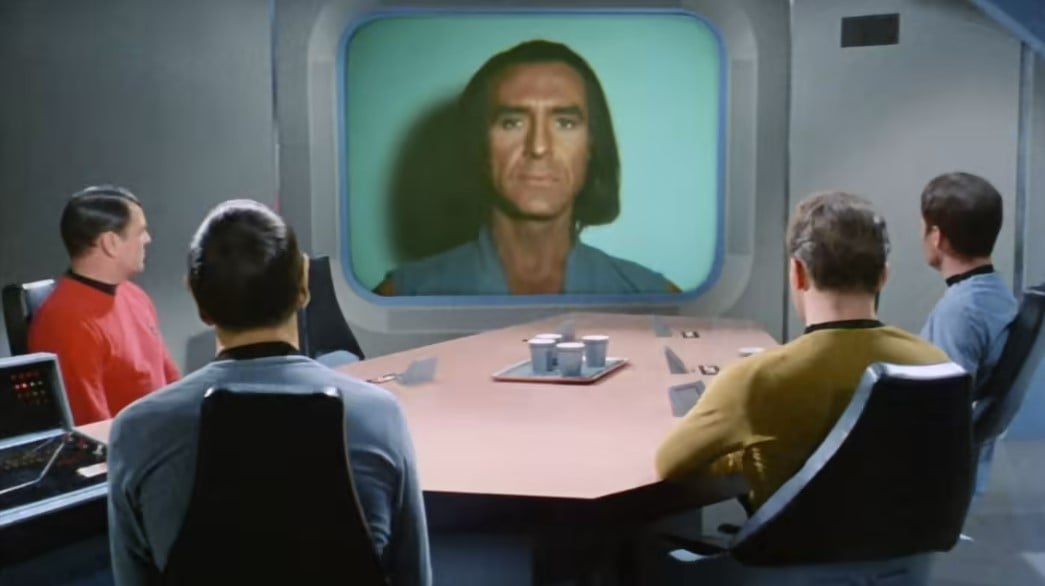
Even people who have never watched Star Trek can hazard a guess as to what it’s about: a spaceship trekking through the stars “to boldly go where no man has gone before”. Along the way, the crew of the Enterprise get involved in a whole bunch of wacky misadventures.
The crew of the Enterprise were a well-organized bunch though, and they stayed in touch through video communications. Video calls were the norm whether you were communicating with officials from Starfleet or hostile aliens. Fortunately, we seem to have overcome the whole phase of “you’re on mute” blunders by the 23rd century.
While we’re still waiting for the technology that will allow Scotty to beam us up, Star Trek’s communication device was interestingly enough the inspiration for the first ever mobile phone – the Motorola DynaTAC. What started as a flip phone, weighing in at 800g with a whopping 18 minute battery life, created an entire industry of smartphones, tablets and laptops, all capable of high-speed video calls with top quality visuals and audio.
Star Trek has given us a lot to be grateful for, including tips on how to run an effective virtual meeting.
2. Star Wars (1977)

In 1977, George Lucas introduced a galaxy far, far away and pop culture has never been the same. The story follows a misfit group of robots and aliens who try to save the universe from an evil galactic empire, as well as rescue Princess Leia from the iconic villain, Darth Vader.
In a franchise full of spaceships, clones and droids, R2-D2’s projection of Princess Leia is the most accurate technological prediction Star Wars made. This scene was an early example of technology used for asynchronous communication. Thankfully, today’s remote teams don’t need an R2-D2 to get their message across to colleagues. An async communication tool like tl;dv will do just fine.
What we lack in translucent holograms we make up for in emojis and carefully worded sentences. We still write emails, update Trello, or record on Zoom – these are our async collaborative methods – but if Slack released an update where you could send a hologram that beamed out of a robot instead of hearing that little clicky ‘message received’ noise, I think most people would be a little taken aback. Until the paradigm shifts in favor of holographic projections, we’ll just stick with Zoom and Google Meet.
Among the many failings of the Jedi in the waning hours of the Republic, perhaps the most fateful was their invention of the dreaded “hybrid meeting format” pic.twitter.com/tWOX0yqnvc
— Erik Baker (@erikmbaker) January 2, 2022
3. 2001: A Space Odyssey (1968)
2001: A Space Odyssey is another sci-fi classic that follows a team’s journey through space with their creepy robot assistant, HAL. When the crew begin to suspect HAL doesn’t have their best interests at heart, the robot lip reads their secret conversation and promptly decides to f*ck them up. It ends with the protagonist hurtling through a psychedelic wormhole of time, space and dimensions, morphing with eternal light beings and just generally tripping out for a good fifteen minutes.
While the baffling ending still divides viewers, and we’re yet to send people to Jupiter, 2001: A Space Odyssey does feature a full-on video call more than thirty years before everyday people had the devices to do so. The ominous movie foretold the quasi-ubiquitous use of video calling as a way of staying in touch over long distances.
If 2001: A Space Odyssey got video calls so spot on, what can we expect from the future of robotics? If we start putting Siri or Alexa inside robots, we’re gonna have some real trouble.
4. Metropolis (1927)
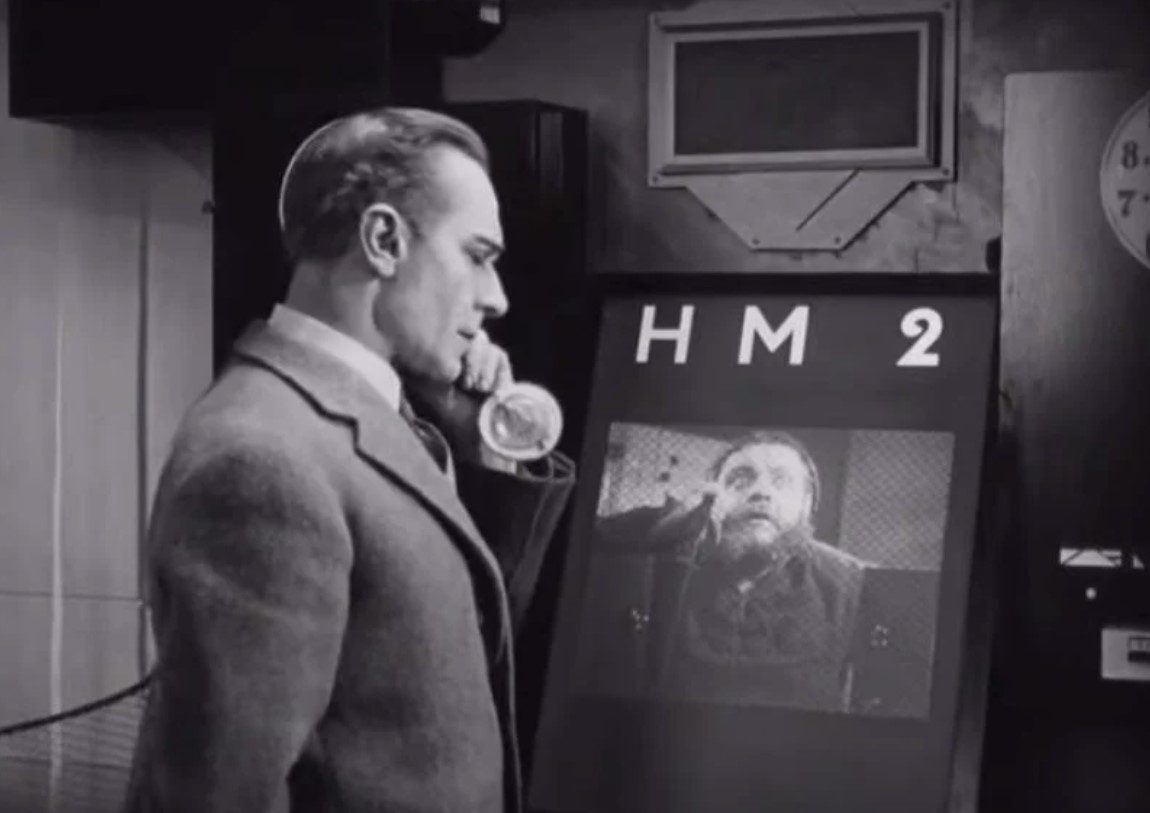
Metropolis is the oldest movie on this list, coming in at nearly 100 years old. It’s thought to be cinema’s first depiction of video conferencing technology, yet the movie itself is a silent one. The story follows star-crossed lovers in a class divided, futuristic society.
The wall-mounted “videophone” used for the iconic video call scene is a bulky and ugly piece of kit – thank god it was only the concept that came true and not the design.
5. Back to the Future Part II (1989)

The second installment of the Back to the Future franchise sends the two protagonists, Rick and Morty – sorry, I mean Doc and Marty – to the future, leaving them needing to get back to… the past. In their future world, older Marty loses his job on the equivalent of a Zoom call. According to one viral TikTok, this is currently what remote workers all over the world are experiencing in 2022.
@tldv.io This is a joke. Only Ian can make it. Because he lived it. #layoff #whatis #meetings #sync #corporatehumor #fired ♬ original sound – tldv.io
As an everyday part of life in 2015, the year the movie is set, we can safely say that they hit the nail on the head with their prediction of video calls. And, despite being a self-fulfilling prophecy, hoverboards are actually a thing now too. Still no flying cars, sneakers with power laces, or psychedelic tie fashion though…
6. The Jetsons (1962)
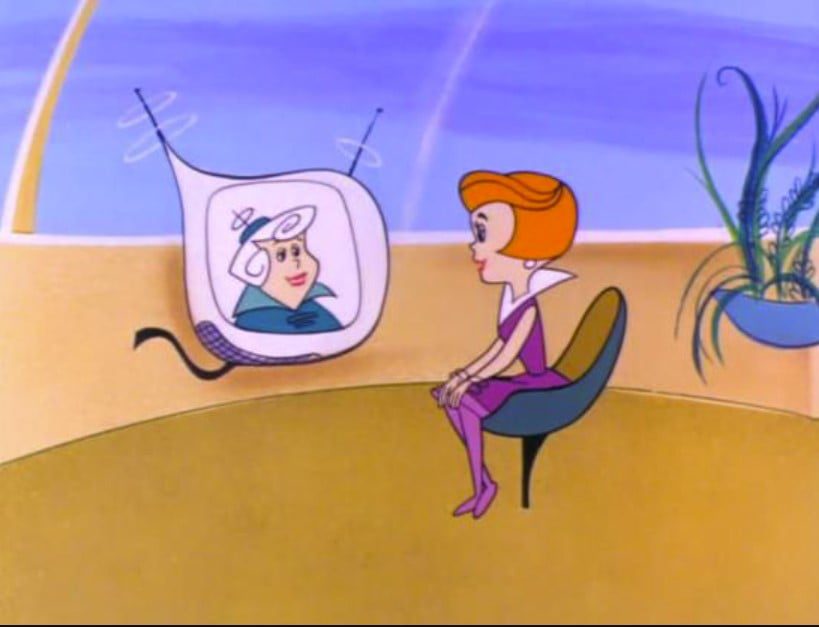
A Space Age counterpart to The Flintstones, The Jetsons lived in a technologically advanced society sometime in the future. The show featured all sorts of whimsical science fiction elements like aliens, robots, and crazy inventions. Of all the yet-to-be-seen inventions in The Jetsons, there is one not-so crazy one: the video call!
The videophone took many forms in the world of The Jetsons, but it was always a dedicated piece of kit just for video calls. It was used frequently by nearly all the characters as this was the main means of long-distance communication.
While they were off the ball with many of their predictions, this one was almost entirely accurate. And what a good thing that is. There’d be comparatively little remote work without it.
7. Demolition Man (1993)
Demolition Man is a cult classic featuring Sylvester Stallone, Sandra Bullock, and Wesley Snipes – bonus point if you remembered that Jack Black had a brief bit part. The movie, set in 2032, focuses on a convict that escapes from the California Cryo-Penitentiary after he is thawed out for a parole hearing. The cop who caught him (Sylvester Stallone) is then thawed out to catch him again. Classic 90s fun.
While the contrast of the film’s humorously “utopian” backdrop against the main characters’ brutality is what makes it memorable, it’s served as a prophet for several technologies, the important one being: video conferencing.
We aren’t yet cryogenically freezing our criminals, but we are definitely spiraling into a world of increased censorship and restricted freedom of speech. With the accuracy of the prediction of video conferencing, who knows if the machine that fines you for swearing will be the way we all get toilet paper in the future…
8. Blade Runner (1982)
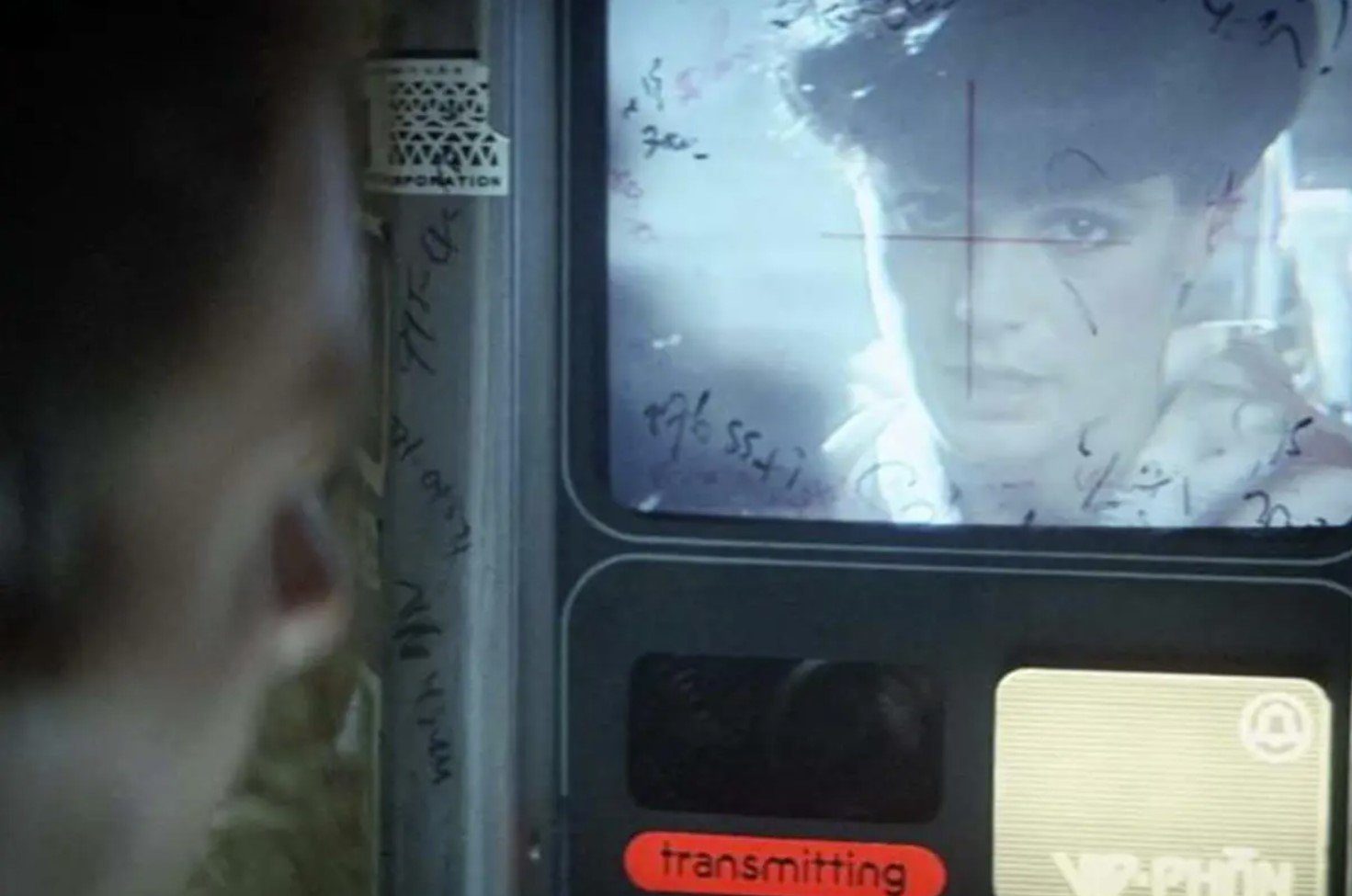
Blade Runner is the second film on this list to feature Harrison Ford – this time as a cop hunting down replicants, rogue cyborgs disguised as humans, that have returned to earth to find their creator. While the movie plunges the depths of what makes us human, it’s the technology that we care about here. And yes, Deckard used a video phone to call replicant-on-the-run, Rachel. It also costs him $1.25! Rip off!
In the midst of society-altering technologies like cyborgs, voice identification and flying cars (again), Blade Runner cleverly sprinkles advancements in tech that were already well-established in science fiction at that time, including a funky cyberpunk hair dryer and the aforementioned video phone. In fact, video calls have been a thing for decades, but it wasn’t until Skype’s launch in 2003 that they became more mainstream.
9. 1984 (1984 – based on the book from 1949)
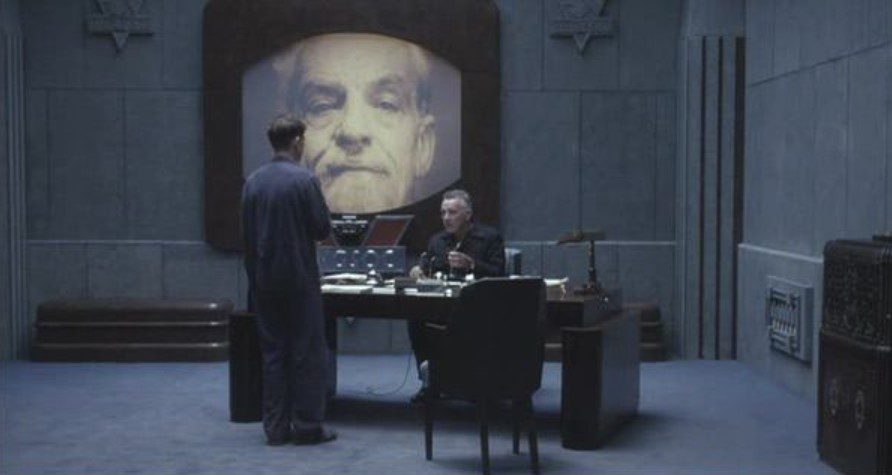
1984 is a novel written in 1949 by George Orwell. It foretells a dystopian future where every person has a telescreen in their home – a two-way television set that enables Big Brother to watch their every move. They are fed propaganda in the form of newspeak, kept patriotic by interminable warfare, and could be imprisoned for their thoughts and beliefs. Turns out video conferencing was the least of Orwell’s correct predictions!
Having said that, 1984’s surveillance state was largely able to work because of its telescreen technology. Of course, telescreens weren’t only used to spy on your every move – they also made great devices to hold video conferences! How else was the total enslavement of mankind planned?!
In the year 1984, a movie of 1984 was released for the first time.
10. Thunderbirds (1965)

Operating from an island in the South Pacific, the Thunderbirds are a group of genius puppets dedicated to saving lives with state-of-the-art machinery. You’d best believe video calling software was included in this state-of-the-art machinery. How else would they be communicating whilst saving the world?
Similarly to Star Trek, the team in Thunderbirds communicates effectively via video conferencing well before it was ever a thing. It’s safe to say the famous British show wouldn’t be the same without it.
The Future of Video Conferencing
So if all these TV shows and movies predicted the type of video conferencing we have now (or near enough), what lies in store for the future?
Fortunately we still live in a world devoid of murderous robots, defrosted criminals, and evil galactic empires (at least, as far as we know). Video conferencing technology, however, is something the 21st century can lay claim to.
The future begins with tl;dv’s sci fi technology: cut down on your team’s online meetings by transcribing and recording video calls, timestamping the important bits, and tagging team members who aren’t present. When you move into this brave new world, you can start catching up on meetings in minutes.
tl;dv won’t help you communicate with aliens or androids, but you can at least enjoy remote calls with your team, candidates, clients and prospects in the most effective way possible. Save hours of time every week – without ever missing a thing!
And the best bit? tl;dv is completely free.













